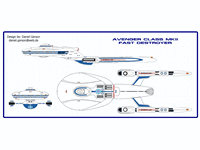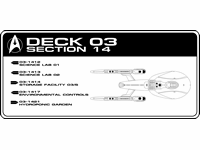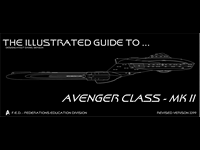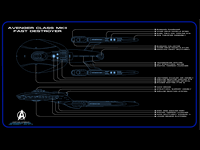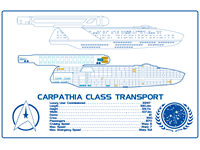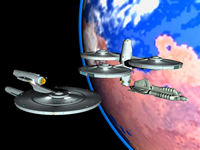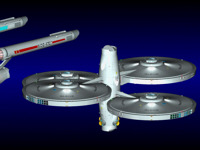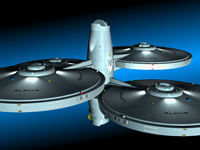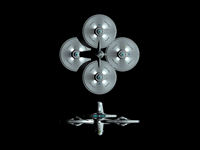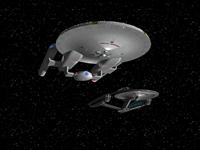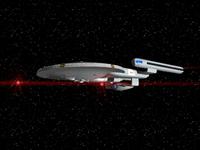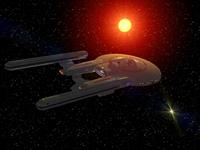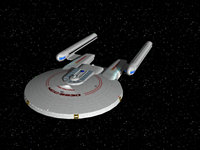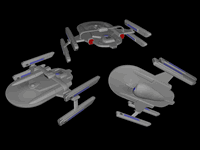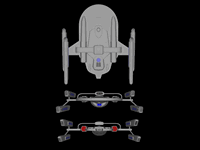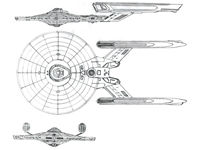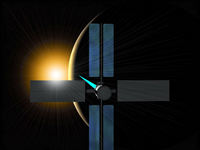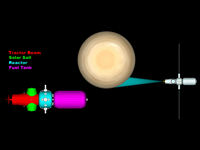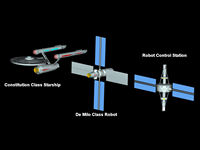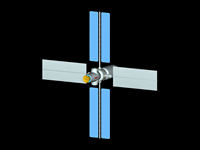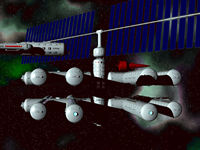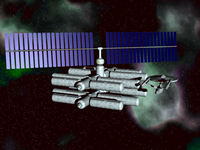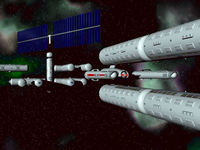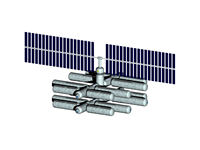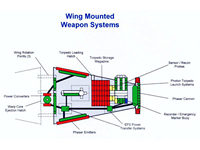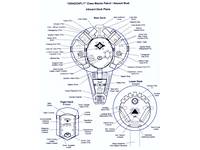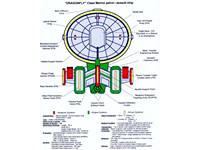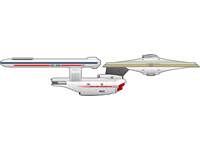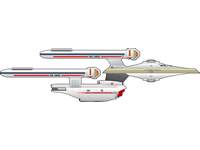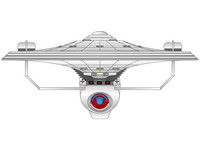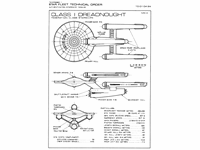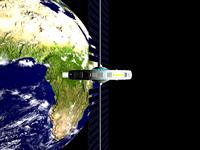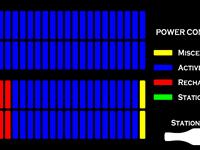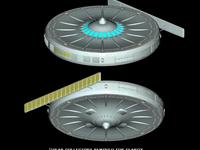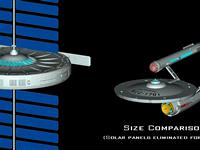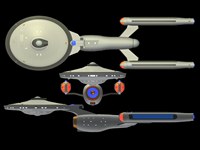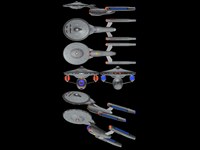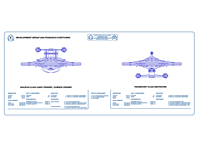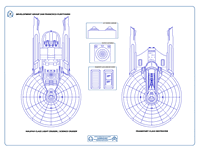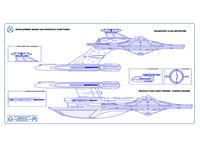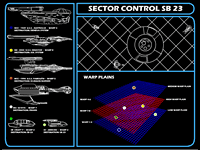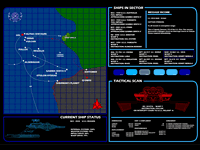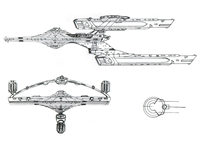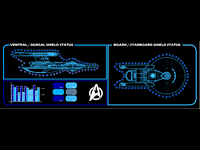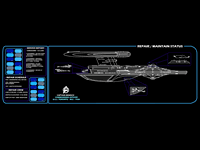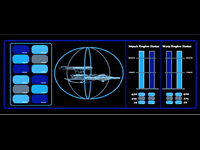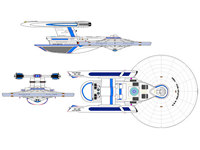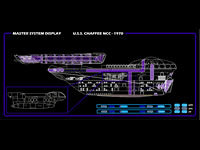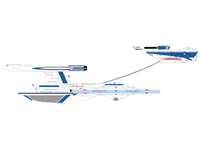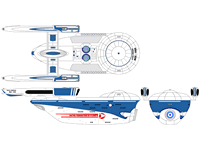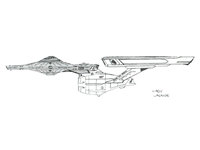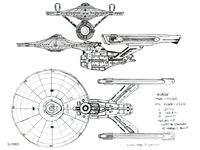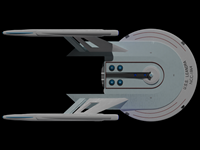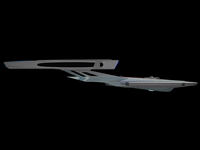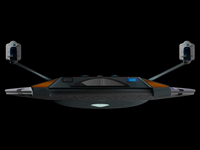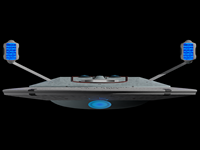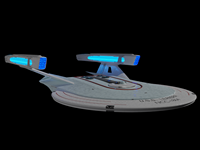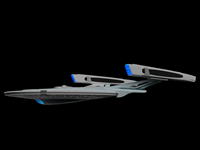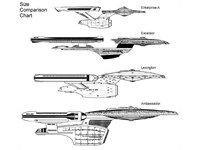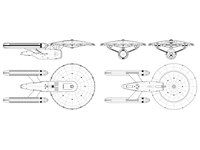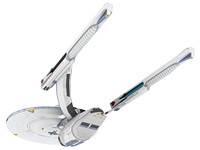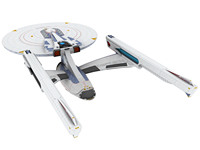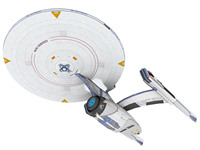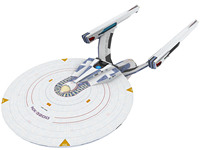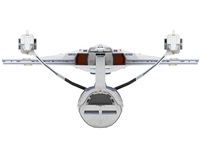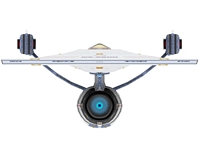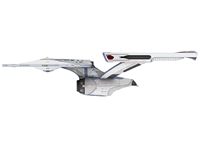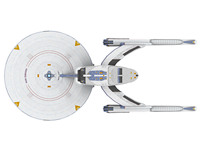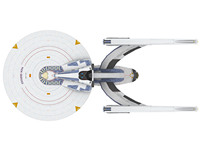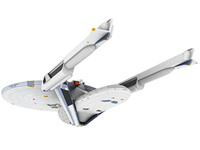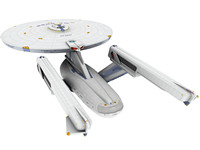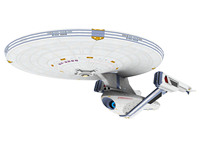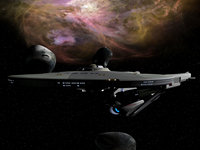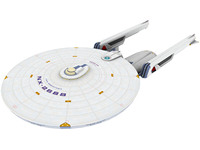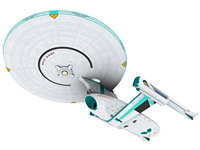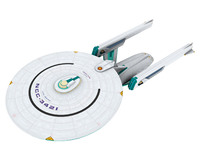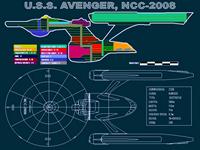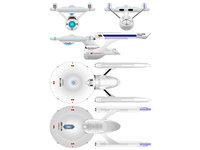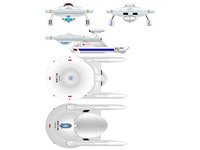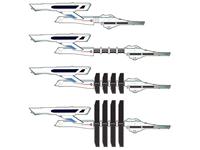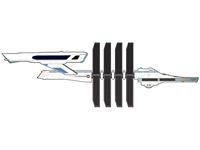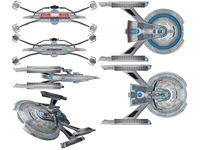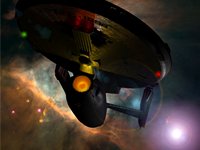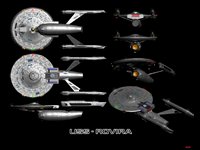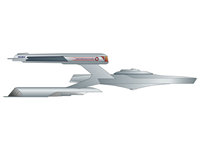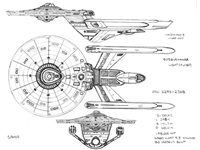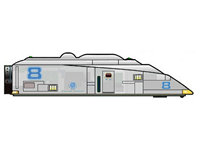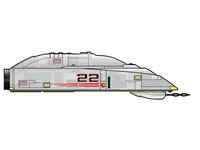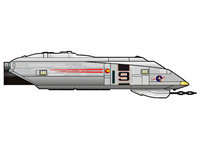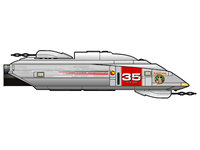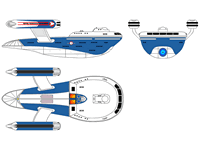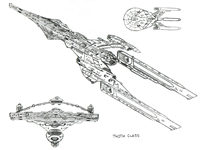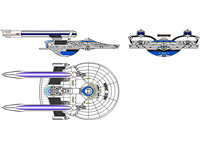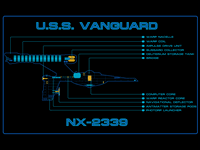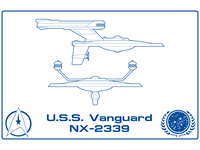Late 23rd Century
History, 21st Century, 22nd Century, Early 23rd Century, Late 23rd Century, Early 24th Century, DY Starship Family
Avenger II Class
Design by Daniel Gerson
Type: Fast destroyer
First commissioned: 2275
Length: 298m
Width: 95m
Height: 45m
Decks: 15
Displacement: 480.000t
Complement: 5 officers + 137 crew, evacuation limit: 210
Speed: Warp 6.4 (cruise), Warp 7.8 (max.), Warp 9.2 (max. emergency)
Armament: 2x Type-VIII double phaser emitters (saucer); 2x Mark III single fire photon torpedo launcher (fore/aft)
Defense: 4x Type-VIII single phaser emitters (saucer)
Embarked craft: 2x Workbee 1x Type 3 Shuttlecraft
The Avenger Mk. II refit, commonly known as the Avenger II, is a swift, capable Starfleet destroyer of the later half of the 23rd century. The original vessel, a highly capable, long range destroyer, was perfect for guarding the borders of the Federation and providing supporting fire for its larger comrades during full-scale fleet engagements. The Avenger-II built greatly upon these abilities, adding tremendous versatility to the class.
A pair of sleek new Pegasus-V Warp nacelles provided a marked improvement in both engine efficiency and maximum velocity and cruise speed. Retooled impulse drives standard with the refit provide a 17.4% speed increase over the stock model at sublight speeds, allowing the ship to slightly best the Miranda and Constitution-refit classes acceleration up to top speed. 2 refurbished torpedo tubes provide heavy punch, while 6 phaser emitters of both double and single varieties provide all-around coverage.
The ship has greatly enhanced capabilities in terms of cargo and shuttle space. Modernization and alteration to the ship's shape allowed two shuttlebays to be installed, one in the engineering hull in the traditional down style, along with two overhead hatch shuttlebays aboard the saucer. This makes the ship excellent for quick strike missions; the Avenger II can punch through enemy lines, leaving its slower allies to engage enemy forces, and disgorge multiple shuttlecraft before retreating, allowing strike teams or essential supplies to be ferried to a friendly installation or colony.
The Avenger-II increasingly sees frontline service and is a favorite to supplement the larger Constitution. It is not uncommon to see several Avengers paired with two Mirandas and a single Constitution or larger ship in Starfleet battle groups. With the introduction of the new, fantastic generation of starships heralded by the Excelsior, the Avenger-II is likely to be shifted to less high priority duties, but will certainly remain a valuable fleet asset for years to come.
Thanks to USS Paladin of SCN for his description.
Carpathia Class
Design by John Bullerwell
Type: Luxury liner
First commissioned: 2297
Length: 330m
Width: 107m
Height: 60m
Decks: 12
Complement: officers + 390 crew, evacuation limit: 3500
Speed: Warp 5 (cruise), Warp 7 (max.), Warp 8.2 (max. emergency)
Sublight speed: 0.65c (max.)
Armament: Standard phasers, 2 banks each fore and aft; 1 bank dorsal
Defense: Standard deflector shields
Embarked craft: 8 Type C shuttlecraft
A luxury liner designed for the Federation by the San Francisco Fleet Yards civilian design division. Sporting the latest in late 23rd century luxury amenities, it is designed for medium to long range cruise voyages in core Federation space.
Cestus 3 Alpha
Design by Robert Heckadon
Type: Diplomatic station
First commissioned: 2268
Length: 280m
Width: 280m
Height: 119m
Decks: 33
Displacement: 2400000t
Complement: 80 officers + 520 crew, evacuation limit: 2000
Armament: 8 phasers; 2 photon torpedo launchers
Defense: Cast rodinium defence shields
Embarked craft: Standard shuttle craft
"Gentlemen, you can't fight in here! This is the War Room." - Peter Sellers, Dr. Strangelove
On stardate 3045.6, a landing party from the starship Enterprise discovers the observation outpost on Cestus 3 has been destroyed, and the landing party itself came under fire from the attackers known as the Gorn. At first it was determined that the attack was a prelude to an invasion, which later was then learned under unusual circumstances that the attack was response of the Federation's incursion in Gorn space. In the year 2268, Cestus 3 Alpha was commissioned in order to prevent another misunderstanding between the Federation and the Gorn Hegemony, and to inform the other party of any movements within the disputed areas.
Cestus 3 Alpha is a medium size station that is recognizable by its 4 saucer habitat sections and vertical engineering section. Each saucer had large scale viewports that contains hydroponic gardens to mimic Earth and Gorn environments. One of the most interesting features of Cestus 3 Alpha is that its shuttle bay deck is on a 90 degree angle to the rest of the station. Or instead of going from side to side, the decks go up and down. This was done to reduce the overall size and complexity of the space station. Rather than having the standard 2.8 metre deck to deck distance, the space station has a 3.2 metre deck to deck distance for the larger Gorn bodies.
Originally the space station was to be designed with a large solar collection array, however a balancing problem abandoned the solar array, and the space station is powered by a combination of nuclear fusion and matter/antimatter reactors. With the risk of an attack from a third party to spark a conflict between the Federation and the Gorn, the space station is armed to nearly 80% capacity of a Constitution class starship. The designers were thankful that despite what they believed before, 50% of the Gorn are actually herbivores, and the omnivorous and carnivorous Gorn can ingest protein re-sequenced meat without any problems. So there was no need for a slaughterhouse aboard the station.
Cestus 3 Alpha's shuttle bay is one of the first Starfleet shuttle bays to use atmospheric force fields to allow a shuttle craft to enter and exit without depressurizing the entire shuttle bay. The force field is activated just inside the doors while the atmosphere between the field and the doors is evacuated prior to the opening of the outer doors. The shuttle craft activates its shields and matches its frequencies to that of the force field and deactivates it thrusters allowing it to drift through the force field without compromising the bay's atmospheric pressure. This was based upon how starships open frequency windows in their shields to allow phasers and photon torpedoes to be fired without lowering the shields.
Despite a 100% success rate and 2 redundant force field systems, standard procedure still calls for all personnel not wearing EVA suits to vacate the shuttle bay in the event of force field failure. It won't be for another 13 years until a variable phase inverter is developed for the force field to only contain oxygen and nitrogen which would allow shuttles to pass through the force field without having to activate shields and match the force field frequency. Trace atmospheric gases including carbon dioxide and water vapour are held in suspension by the atmospheric pressure.
The station came under fire by critics when they realized that the Federation personnel and the Gorn personnel are not housed in the same sections of the space station, citing accusations of segregation. The reasoning is however not because of political or social reasons, but biological reasons with the Gorn saucers being much warmer than the Federation saucers, since the Gorn can only withstand temperatures below 30 degrees for a limited amount of time. As well there have been no complaints from the Gorn Hegemony about the separation of the 2 cultures. In fact, they were thankful that they didn't need to be around "that smell" for very long. Thermal build up in the Federation saucers is transferred to the Gorn saucers for energy conservation.
Critics have commented that the station's engineering section looks more like a brewery rather than the engineering sections of starships and space stations of its size classification. Unfortunately Admiral Pierre Robau**, whose engineering team was contracted to design the architecture and structure of the Constitution class (namely internal and external appearance), had long since retired and the contract for designing Cestus 3 Alpha's engineering section went to Commodore Andrea Dopaso who felt the Jeffries tubes were too cumbersome and more of a nuisance than they need to be, and believed a "brewery" design gave engineers easier access to vital space station components.
In the event of a hull fracture or breach and to eliminate the risk of electro-hydraulic power failure for the emergency bulkhead (as was suffered on the NX-01 Enterprise on January 23, 2153***), Cestus 3 Alpha has been equipped with experimental cylindrical shaped Kevlar balloons to seal off the corridor intersections to drastically reduce the rate of decompression. Repair teams then adds a silicone sealant to more permanently seal the breach until the hull damage is repaired. The balloon is designed to fully inflate in less than 15 seconds with an end pressure of approximately 250kPa. The Kevlar balloons were also installed on the Constitution class USS Lexington for experimental trails. However during the disastrous M-5 multitronic computer tests in 2268, out of the 8 balloons that were needed to inflate, only 3 inflated properly, and 2 failed to inflate at all. Out of the 53 fatalities of that ship, 23 were attributed to the balloon failures, and they were then decommissioned 3 weeks later with less than impressive results from failure analysis division of SCE. Cestus 3 Alpha was then refitted with conventional emergency bulkheads.
With the exception of rumours that Cestus 3 was actually a research outpost examining a below surface temporal wormhole, there has been no real incident between the Federation and the Gorn after the massacre for the 40 years Cestus 3 Alpha was operational. The station was decommissioned in the Earth year of 2309 and replaced with Cestus 3 Beta.
**Admiral Pierre Robau is Captain Robau of the USS Kelvin, and Pierre from the novelization of Star Trek (2009).
***Star Trek Enterprise episodes "Azati Prime" and "Damage".
Columbia Class
Design by Nixon's Head
Type: Cruiser
First commissioned: 2297
Length: 381m
Width: 185m
Height: 69m
Decks: 12
Complement: 60 officers + 390 crew, evacuation limit: 1200
Speed: Warp 6 (cruise), Warp 7.5 (max.), Warp 8 (max. emergency)
Sublight speed: 0.8c (max.)
Armament: 6x twin phaser banks on primary hull, 4 single phasers in aft firing arc, 2x photon torpedo launchers
Defense: Standard defensive shields
Embarked craft: 10 standard personnel shuttles, 5 cargo shuttles, 5 workbees
The Columbia-class project originated in the late 2280's as an attempt to leverage technologies from the Excelsior-class project into mainstream fleet use following the failure of the Transwarp Development Project. Columbia was originally envisaged as a replacement for the Constitution-class exploration cruisers that were at that time reaching the ends of their long and fruitful lives. Named for the famous ship that had served with such heroism during the Earth-Romulan War, the Columbia-class would match the Constitution's scientific capabilities as well as providing the necessary muscle to be an effective deterrent to the leaders of the Klingon Empire.
However, as the preliminary design phase was drawing to a close in 2293 the galacto-political situation was shaken by the explosion of Praxis and resulting detent with the Klingon Empire. Furthermore, the success of the re-fit of USS Excelsior persuaded Starfleet to select that class as its primary cruiser design for the next two decades.
In response to these changes, the Columbia specs were rewritten to adapt the class to a more peaceful duty. The thawing of relations with the Klingons, as well as the enormous economic impact of the Praxis relief effort, meant that many Klingon ships that had previously been menacing neutral sectors were now being pulled back into the Empire proper. This was opening up huge new areas of space that had previously been closed to Federation traffic, and Starfleet was eager to move in and chart these regions, both to expand their scientific knowledge and to establish a presence and picket line should relations with the Klingons turn sour once again.
The modifications to the Columbia mainly involved her tactical and sensor systems. Her weapons load was downgraded to a more peaceful posture, with just six twin phaser banks. In parallel, her long-range sensor suite was expanded and moved into a separate ventral pod to reduce interference from the emissions of the primary hull and warp drive systems. The pod also housed the navigational deflector, one of the more compact and powerful for its size in existence. Finally, two torpedo/probe launchers were added to the pod.
The lead ship of the class, NX-2230, was launched from the Utopia Planitia Yards in May 2297. Over the next ten years she was followed by a further 14 vessels, which together formed the outer defensive and exploration perimeter of the Federation along the Klingon and Romulan borders. Working in tandem with the powerful Excelsior-class cruisers, Columbia-class ships were often the first to alert Starfleet forces of potential border incursions.
The Columbia-class served with distinction throughout the early 24th century. The class had two production runs with a total of 30 starships, and underwent three major refits over its lifetime, before being retired with the introduction of the Nebula-class in the 2360s. A few hulls were reactivated for the Dominion War effort, but those that survived that conflict were quickly deactivated once again as part of the general demobilisation. The last ship, USS Hernandez, NCC-4202, was decommissioned in August 2376 and donated to the Columbia Historical Society. She was renovated and placed on public display at the Starfleet Museum Tellar Annex in 2380.
Condor Class
Design by Edymnion
Type: Explorer
First commissioned: 2287
Length: 249m
Width: 236m
Height: 64m
Decks: 14
Displacement: 855000t
Complement: 6 officers + 350 crew, evacuation limit: 600
Speed: Warp 6.5 (cruise), Warp 9.2 (max.), Warp 9.6 (max. emergency)
Sublight speed: 0.5c (max.)
Armament: 6 type-7 phaser banks (4 foreword, 2 aft), 4 pulsed phaser cannons (2 forward, 2 aft), 3 photon torpedo launchers (2 forward, 1 aft)
Defense: Standard deflector shield arrays
Embarked craft: 2 shuttlecraft
After the failure of the U.S.S. Excelsior's transwarp technology in 2285, Starfleet engineers turned to making a high warp capable ship using existing technologies. They began with the basic frame of the most reliable starship class to date, the Miranda, and began work. Two years later, the U.S.S. Condor launched from the Utopia Planitia shipyards in Mars orbit. The Condor class featured a combined primary and secondary hull, four high efficiency warp nacelles, and a pair of high power impulse engines along with an interchangeable sensor/weapons pod similar to that of the ship's inspiration, the Miranda. The aft of the ship also contains a shuttle bay, containing up to two shuttlecraft for planetary ferrying and short-range recon.
Capable of extended periods of high warp travel and enough sublight power to overcome any foreseeable disturbance, it was hoped that the Condor class would help push back the boundaries of explored space. However, that was not to be. The Condor quickly became the butt of many jokes for being engine overkill, that no starship would need that much engine power under normal circumstances. Which, as was the case, was quite true. The relaunch of the Excelsior line and subsequent advances in warp technology rendered the class obsolete before its time. While the line did see use as a long-range exploration vehicle, several of which gained a measure of notoriety, it was mainly relegated to boarder patrol.
Of all the Condors created, the majority of them are still in commission well into the 24th century serving a variety of purposes. Many still patrol the outlying boarders of the Federation or make relay runs between the Deep Space stations, several of which were present in the fleet to retake the Deep Space Nine station during the Dominion War. Some of the less fortunate Condors have also been demoted to the status of a tug ship because of the strength of their sublight engines. A rather ignoble end for a ship that once held so much promise.
Cymru Class
Design by James Donovan
Type: Frigate
In service: 2267-2315
Length: 287m
Beam: 141.7m
Draft: 48.5m
Mass: 155,000 t
Decks: 11
Speed: Warp 7 (std.), Warp 9 (max.)
Crew complement: 165
No description
De Milo Class
Design by Robert Heckadon
Type: Terraforming robot
First commissioned: 2270
Length: 119m
Width: 263m
Height: 254m
Displacement: 120000t
Sublight speed: 0.001c (max.)
Armament: none
Defense: none
Embarked craft: none
"Reaching, searching for something untouched, Hearing voices of the Never-Fading calling" - Amaranth; Nightwish
Venus, also known as the morning star. Named after the Roman goddess of beauty and the consort of Vulcan. Its name alone conjures images of incredible beauty and stories of a planet ruled by Amazon women. But in reality Venus is a fiery hell with temperatures and pressures high enough to melt lead.
Yet there are dreams of taming Venus and make it into a world like Earth through a process known as terraforming. And one crucial step in the terraforming process is to reduces Venus's day from 243 Earth days (retrograde) to 16 hours. By increasing its axial rotation from 6.5 km/h from east to west, to 2375 km/h west to east. A task best suited for the De Milo array.
First commissioned in 2270, the De Milo array uses a series of powerful robots, simply referred to as De Milo class, that uses brute force to increase Venus's axial spin. They lock onto the planet with tractor beams on the planet's "west" side on a near tangent angle to Venus. The robots then uses an electromagnetic solar sail, similar to the M2P2 drives used by the DY-100 sublight cruisers, to propel the robot. Both tractor beams and solar sail are boasted as being the most powerful built by Earth.
The robots accelerate Venus's rotation at a rate of 14.2km/h/year, which would take approximately 167 years to complete. The reason for the increasing its rate of rotation are for thermal dissipation, magnetic field generation, and a more proper sense of night and day.
The tractor beams used by the robots uses a two-way tractor emitter with one beam aimed towards Venus and the other aimed inside the robot. Within the robot, a series of subspace coils generates what is called a gravimagnetic matrix which allows the internal tractor beam to lock onto the solar sail's electromagnetic field itself. And with the two-way tractor emitter, this virtually eliminates the robot from any real physical interaction with its solar sail, tractor beam, and Venus. This also virtually eliminates the structural limitations of the robot due to the fact that even with such a low acceleration of 14.2 km/h/year, with Venus's mass being 4.87 billion trillion metric tonnes, even with the forces divided between 50 robots, the amount of force per robot is approximately 21.2 million billion Newton per robot. Or using old English measurements, 2.73 million billion pounds per robot. No known material within the Federation can withstand those forces.
The gravimagnetic matrix is highly sensitive and fragile, and requires warp control systems used in faster than light starships to maintain. If the matrix were to ever fail, the internal tractor beam could lock onto the robot's interior and destroy it from the inside out. Warp control systems are also used in the balancing of the forces generated by the robot's tractor beam and solar sail.
The robot's solar sail generates a powerful magnetic field that allows the sun's solar winds to push against it, generating thrust. With the accumulated magnetic field strength of 50 robots, the solar sail expands to a diameter of nearly 220,000km. Nearly one-quarter of the diameter of the sun.
The robots are powered by a series of nuclear reactors whose fusion rate is so high, they can maintain the warp drive of a Constitution class starship at warp factor 8. This also means that the robot's fuel supply will be exhausted in less than a week. The plasma exhaust is then vented into the solar sail itself to enhance the magnetic field. The robots uses a highly advanced cooling system to prevent the nuclear reactors from over heating. And often the cooling systems are working at 90% + capacity. There have been instances where the heat dissipation fins had begun to glow red. The robot's duotronic brain and thrusters are powered by solar energy.
The De Milo array uses 70 robots, with 50 of them active and 20 of them in reserve. The extra 20 robots are primarily used to rotate with the 50 robots for refit and repair time, as well in the event a robot is destroyed or disabled. By 2310, 22 robots were destroyed by overloads, gravimagnetic matrix failures or other problems. But fortunately a rate with the robots can be replaced at a decent rate. The robot control station is in Venus's polar orbit being very careful not to be caught by any of the robot's tractor beams. Secondary emitters locks onto another part of Venus to compensate for the planet's rotation.
The De Milo robots have often been targeted by critics. Critics have asked why not have the robots be powered by matter/antimatter reactions? Though the amount of antimatter required can be attained by a dedicated antimatter refinery, the dilithium requirements would far exceed the cost of the project. Plasma fuel cells are also dismissed due to the fact that the solar sail prevents the solar winds from even reaching the robots. As well, the amount of fuel required would be having to refuel the robot literally every few minutes.
Critics have also asked why not simply use a matter/antimatter thruster? Even with the same energy output, the matter/antimatter thruster would only generate at the most 10% the thrust required. The thrust from the solar sail comes from the matter expelled from the sun. As well, the robot's structure cannot withstand the stresses of the antimatter thruster while anchored to the planet Venus.
Critics even asked why not simply use warp drive? Aside from structural reasons, warp drive are not Newton based propulsion systems. Warp drive moved space towards the ship at faster than light speeds, but they cannot apply kinetic energy onto anything the way impulse engines can, which is needed for Venus. Meaning when a faster than light ship is anchored to Venus via tractor beam, all the engines will do is build up space between the planet and the ship, which will destabilize the tractor beam. And even if the tractor beam holds, it will collapse the warp field pulling the ship out of warp instantly.
Critics also claimed that a deflector, not a tractor beam, would be more suited for the task and reduce the complexity of the robots. The deflector concept was considered before with a test robot in 2262 and an asteroid, however stability problems occurred as well as incompatibilities with the gravimagnetic matrix. And the complexity if the robot was in reality much greater.
In 2271, a milestone was achieved when the robots were able to stop Venus's retrograde rotation. In 2306, it was decided that rather than Venus having 16 hour days, it will have 20 hour days. This is because with Venus beginning to develop its own magnetic field, the centre of the accumulated magnetic fields begins to shift towards the centre of the planet, making it more difficult to increase its axial spin. So rather than it requiring 167 years, ending in 2437, to complete this stage of terraforming, it will only require 134 years instead, ending in 2404.
Even then, though the Van Allen's Belt would be closer to the surface of Venus, the magnetic field strength would be strong enough to protect the future colonists of Venus. As well the stronger sunlight on the planet will allow photosynthetic plants to clear the planet of greenhouse gases, making it reasonably cool.
Over the years the De Milo robots have been routinely upgraded especially with the replacement robots to those that were destroyed, and in 2368, 90% of the robots were powered matter/antimatter reactions and synthetic dilithium. By 2404, 49 robots were destroyed and 22 heavily damaged. But their sacrifice paved the way to the first steps into turning Venus into a true sister of Earth.
Deep Space 2
Design by Robert Heckadon
Type: Deep space outpost
First commissioned: stardate 7420.1
Length: 461m
Width: 444m
Height: 287m (Dimensions exclude solar array for clarity.)
Decks: 83
Displacement: 3300000t
Complement: 200 officers + 2500 crew, evacuation limit: 10000
Armament: 24 phasers; 4 rotating photon torpedo launchers
Defense: Magnetic radiation shields; Cast rodinium shields
Embarked craft: 25 standard shuttles; 10 cargo shuttles
"Funny how comedians makes more (political) sense than politicians." - Dr. Mark Piper
Located in the Gamma Pegasi (Algenib) star system, 335 light years away from Earth in the constellation of Pegasus, Deep Space 2 is the Federation's newest deep space outpost. Commissioned in 2272, it serves as a waypoint for deep space exploration cruisers to expand the final frontier.
Deep Space 2 is a modular space station that is based upon the Space Island class star base. Based upon the standard cargo and shipping containers used by the Federation, each module is 40 metres in diameter and 150 to 200 metres long. The modules are constructed in a shipyard on Mars to take advantage of the planet's low gravity to lift the modules off the surface. They are then transported via tug ships to the Gamma Pegasi star system where they are then assembled.
The modules consists of the following:
- 4 - 200 metre long; 40 metre diameter service modules,
- 8 - 200 metre long; 40 metre diameter habitat modules,
- 8 - 150 metre long; 40 metre diameter habitat modules,
- 1 - 200 metre high; 40 metre diameter command module,
- 1 - 33 metre high; 40 metre diameter engineering module,
- 1 - 657 metre long solar array
Though considered small for a major space port, the modular design was deemed the best option for such a deep range outpost. And despite its size, it is capable of handling various diplomatic missions, layovers, and significant repairs to deep range spaceships.
Deep Space 2 then inspired Deep Space 3, only with some redesigning. Specifically the engineering module on the bottom of the station instead of the top, and the solar array replaced with a rotating Bussard collector/plasma fuel cell combination.
Dragonfly Class
Design by Tony Lee Jones
Type: Marine patrol/assault ship
First commissioned: 2285
Length: 105m
Width: 80m
Height: 25m
Decks: 3
Displacement: 18000t
Complement: 4 officers + 16 crew, evacuation limit: 30
Speed: Warp 8 (cruise), Warp 9 (max.), Warp 9.5 (max. emergency)
Sublight speed: 0.99c (max.)
Armament: Ten type 7 phaser emitters; three MK 7 phaser pulse cannons; four MK 10 photon torpedo tubes
Defense: Type 3 defensive shield; detection countermeasures; exterior ablative armor hull coating
Embarked craft: None
The Dragonfly series assault ships were designed to transport and deploy two squads of marine light infantry. The squads double as the ships crew. Dragonflies can operate alone or in groups. For long distance deployment, they can be loaded into special containers and taken anywhere by Starfleet transports. They can also deploy troops in deep space on directly on to surface engagements.
For Joey and Wade. Thanx!
Dreadnought Type
Design by Kris, ASDB Member
USS Entente
Length: 345m
Height: 73m
Beam: 164m
Decks: 17
USS Federation
Length: 341m
Height: 92m
Beam: 164m
Decks: 16
The Starfleet Technical Manual by Franz Joseph depicts a three-nacelled "dreadnought" of the Federation class. The USS Entente NCC-2120 mentioned in STTMP was classified as Federation class in the STTM. Kris has developed a design that fits into the movie era. Decide for yourself if the two-nacelled or three-nacelled version is better.
Emory Erickson Class
Design by Robert Heckadon
Type: Transporter station
First commissioned: 2257
Length: 183m
Width: 178m
Height: 1258m
Decks: 16
Displacement: 225000t
Complement: 82 officers + 518 crew, evacuation limit: 3000
Defense: Cosmic ray magnetic shields
Embarked craft: Docking shuttles
"The scientific theory I like best is that the rings of Saturn are composed entirely of lost airline luggage." - Mark Russell
In the second quarter of the 22nd century, Emory Erickson built Earth's first teleportation device simply referred to as the molecular transporter. In 2257, the first Emory Erickson class transporter station was commissioned.
The Emory Erickson class station is a Starfleet built, civilian operated transporter station used to beam people from one point on the Earth and then beams them onto another point on the Earth. The space station is used by business persons, vacationers, archaeologists and scientists, and people who simply live on one part of the Earth and work on another part. The space station is also used to transport cargo and goods from different points on the Earth, as well as dedicated site-to-site transporters for emergency situations. People even uses the space station just for the purpose of spending a few hours in orbit to see their planet below.
The Emory Erickson class doesn't just use the standard 6-person transporter chambers, but multiperson chambers similar to the 22-person escape transporters used on the Constitution class. These range from 10 person to 25 person transporter chambers. As people are beamed up all a mass to the space station, they individually move to another transporter to beam them down to their destination. This is because that though they may have the same starting point, their destination are quite often different. As well as though the people have the same destination, their starting points are also quite often different.
Within the station, though the station contains turbo lifts that can transfer people to certain parts of the station, they are incapable of mass transit within the station. And so the station uses escalators for the travellers to transfer from one transport deck to another.
With the amount of power used by one, 6-person transporter, the Emory Erickson uses 120, 1098 square metre photoelectric panels to allow the transporters to be powered by solar energy. The number of solar panels on the Emory Erickson class is considered heavy for a space station of its size classification. The solar panels rotate on the station's axis to keep the collectors facing the sun continuously. During the 40 minutes the space station falls under the shadow of the Earth cutting off its solar energy, the space station is then powered by 5 rechargeable plasma fuel cells. To reduce the power loads on the space station, normally no more than 5 transporters are used simultaneously, and a delay of at least 30 seconds from the completion of one transport activity to the activation of another transporter to allow time for the space station to recharge. The space station uses a matter stream transmitter/receiver array, pointed at the Earth, to beam people to and from the Earth.
Aside from deck separations, the internal coordinates of the space station are colour coded, based upon an native North America medicine wheel, for increased ease of finding their way around the space station. Yellow for east, red for south, black for west, and white for north. The station's running lights are arranged in the same way, only with blue replacing black for visibility on space. Since the space station orbits the Earth from west to east, for a person to is travelling west, they are beamed up by an Emory Erickson station west of the departure points location, and transports them west. The Emory Erickson class orbits the Earth at a distance of approximately 6400 km over the surface of the Earth. At this orbit, it takes the space station only 4 hours to complete one orbit.
Since transporters require line of sight transmission, this gives the Emory Erickson class a maximum range of just over 11000 km, even with the transporters having a standard maximum range of nearly 25000 km. This is because the transporters cannot beam through solid rock more than 1 km thick, and therefore cannot beam through the Earth. But even then, this allows the space station to beam anyone in a 140 million square kilometre area on the Earth, out of over 500 million square kilometre area on Earth, including the ocean areas.
Critics have asked why not use a transporter relay satellite in orbit instead of an actual space station? The concept of a transporter relay satellite was deemed far too risky and dangerous, and with a projection of a fatality rate of at best 87%, with about 12% with significant deformities.
Critics have said that the Emory Erickson class station is unnecessary cause most orbiting space stations, including kilometre long space docks, have transporters and thus the population can use those transporters instead. Ironically the Emory Erickson class was developed because of the critics who question Starfleet's status. As well, the space station's transporters cannot handle continuous use, nor the mass transport. As well the power requirements would be staggering to the space station.
Critics had a field day with a condition known as transporter psychosis, which was first diagnosed in 2209 on Delinia 2. Transporter psychosis affects the body's motor functions, autonomic systems and the higher reasoning centres of the brain. And critics maintained that routine use of the transporter would only escalate the damage. However even with heavy transporter usage, only 1 in 20 million people are susceptible to transporter psychosis. And with early detection and prevention kept the number of cases down to a minimum.
In 2322, the Emory Erickson class were replaced with manned site-to-site transporter stations for more flexible teleportation transits.
Eris Class
Design by Diego Barizo
Type: Destroyer
First commissioned: 2269
Length: 226m
Width: 70m
Height: 45m
Decks: 11
Complement: 30 officers + 120 crew
Speed: Warp 6.1 (cruise), Warp 8.5 (max.), Warp 10 (max. emergency)
Armament: 1 forward firing torpedo tube + 6 twin phaser mounts.
Defense: Standard shields
In the 2260's new advanced fire control systems were being developed based on the latest computer technologies. It was expected that this will allow phaser fire to be targeted to specific locations with a high chance of hitting. In an attempt to counter this high precision fire, two ideas for starship design were proposed.
The first called for a much more compact design, reducing and eliminating if possible vulnerable areas, like the neck and pylons. The smaller ship was also expected to be able to avoid being hit altogether, and have improved maneuverability.
The second group thought that even a compact ship will still be hit, and that any shot missing it's intended target would just hit the ship somewhere else. In a very compact ship, another critical system was likely to be there. Therefore, their proposal was a ship that was "stretched", separating critical areas as much as possible. That way, a single shoot could never damage more than one critical system. Advanced field control software, taking advantage of the new powerful computer cores was anticipated to compensate for warp field cohesion problems caused by having the warp nacelles at the very far back of the ship.
Unfortunately, the failure of the multitronic computer architecture forced the use of a more limited control software, that was unable to perform as required. In trials, the first ship of the class was unable to reach the design top speed, and maneuverability at warp was poor for a ship its size.
It was decided then to cancel the series. The advanced fire control system and good low-speed maneuverability did not justify the continuation of the class. The ships were too slow for scouting roles (although they did have a very good sustained cruise speed), too small for most science missions, and expensive for most other roles. After the lead ship completed trials, the second and third one - which where in advanced stages of construction - were finished with modified configurations that tried to improve performance, and the 4th one, about 60% completed, was stored for spare parts.
The Eris was launched in 2269, and after trials, was assigned to R&D, before being decommissioned 11 years later. The Caronte and Ceres had limited front line service for 5 and 6 years respectively, before being transferred to R&D too. Both were destroyed in 2286 near the Klingon border while performing advanced equipment tests.
- NCC-1791 Eris
- NCC-1792 Caronte
- NCC-1793 Ceres
Thanks to all the people in the Subspace Comms Network Artwork and Design forum for their feedback.
Frankfurt Class
Design by Daniel Gerson
No specs available
Citing the need for a new light cruiser to fill the gap in size and capability between the dominant Oberth- and Constellation-classes, design of the Halifax-class began on Earth in 2266, finishing in mid 2268. It was part of the wide-ranging Project Urania, which lead to the Halifax and its brother, the Frankfurt-class light destroyer, along with a host of new technologies and parts that would later be used or adapted to other vessels.
The Frankfurt, a notable destroyer of the 2270s, served as a source of inspiration for the later Freedom-class of the 2360s and MacKenzie-class of the 25th century.Design Proposal 2003A-4 was drafted in 2263, resulting in an intensive study and analysis of the current fleet capabilities and weaknesses. The project was subsequently approved, eventually forming an entire family of small to midsize starships that bridged the Constitution family to the Excelsior and beyond. The Frankfurt was one of the ships derived from the study. Research and design planning began in mid 2364. The Frankfurt would be a destroyer, fast, reasonably manoeuvrable, and well armed, aimed at supplementing the refitted Constitutions and providing fire support for the exciting new Transwarp Excelsior-class.The Frankfurt consists basically of proven design elements, such as the very Constitution-like saucer and similar nacelles to the larger Federation ship. The Frankfurt, however, was one of the pioneers of oval deflector dishes, and mounted its nacelles and dish in a new, unconventional arrangement; a thick neck extended downwards at an angle, containing the powerful dual forward torpedo launchers and main deflector, then branched out into a pair of AW-8.8mx nacelles. The nacelle struts also contain conveyor systems and small cargo bays, accessible from the dorsal side.
The odd placement of the warp nacelles allows higher power to be channelled through the warp field itself; essentially, the overpowered field would interfere less with the saucer's power grid and critical systems if they were placed farther away. The addition of the spine was a large change from the original idea, which mounted the nacelles directly under the saucer, with deflector placement not unlike the later Akira-class. A huge VIIIhd/r phaser cannon sits on top of the dorsal spine, providing devastating punch either fore or aft. While limited in firing angle, this weapon worked to devastating effect, allowing groups of Frankfurts to smash through enemy lines. The small groups of Frankfurts guarding the Federation border were rarely harassed by unwieldy Klingon battlecruisers.
While Starfleet was initially quite pleased with their new destroyer, enthusiasm quickly faded. The Frankfurt, while superior to her Constitution-family cousins, lacked the prowess of Excelsior-family designs. Dissipating tensions with the Klingon lead to a slashing of the initial unit run, but over a hundred vessels were produced. Twenty four were destroyed in Klingon and Romulan skirmishes, while the rest were either retired or demoted to system patrol duties, especially in outer colonies. Jem'Hadar invaders destroyed many of the venerable Frankfurts that remained during the Dominion war. One has been donated to the Starfleet museum, eighteen still serve as border patrol ships, and a further six have been stripped down to research purposes. None remain in active duty within the main fleets; the Norway-class and its unremarkable predecessors largely replaced the Frankfurt.
An interesting concept whose time was cut short by the end of an era, the Frankfurt will forever maintain her rightful place among the other unsung hero ships of Starfleet past.
Grief Class
Design by James Donovan
In service: 2269-2300
Length: 279m
Beam: 165m
Speed: Warp 6 (cruise), Warp 9 (max.)
Mass: 205,000t
Crew complement: 25 officers, 70 crew
No description
Halifax Class
Design by Daniel Gerson
Type: Light cruiser
Length: 245m
Decks: 19, including pylons
Crew: 179
2x photon torpedo launcher (fore)
6x Type-XII phaser turrets
Max. warp: Warp 8.1
Max. cruise: Warp 7.6
Cruise: Warp 7
Project Urania, along with the Excelsior project, laid the groundwork for all designs to come until the next shift in starship design in the early 2300s. The prototype was built, borrowing many components from existing classes, along with newly developed parts designed for the Constitution refit and modern Excelsior class. The USS Halifax herself was completed in 2270, and the class was certified for production nine months later. The starship was produced in two models, each sharing the same space frame and basic systems. The light cruiser model mounted heavier weaponry and featured less scientific capability, while the science cruiser was less well defended but incorporated a plethora of scientific systems.
The Halifax combines both the hardware and style of the Oberth and Constitution, while foreshadowing the future Excelsior and Centaur-classes with a remarkably similar saucer. A large, semicircular science pod sits under the thin engineering hull, while the pair of nacelles is mounted on a pylon above the engineering hull, in a similar manner to the Constellation. Unlike her distance relative, these nacelles are mounted on a pair of supports joined by a long deck, then sit across a long pylon with the deflector mounted in the centre. This odd arrangement provides maximum deflection in the area around the nacelles and upper saucer, while any warp field emissions are reflected perfectly off the contoured hull and out into space.
The two Swift-AE II nacelles provide good power and efficiency, among the best of the ships of her time in overall performance. Sublight propulsion is provided by two huge ASPU Mk 1 engines, mounted on either side of the saucer, and supplemented by two SPU Mk. 9s mounted on the engineering hull. The ship is adequately defended, reflecting the needs of the time. Half a dozen Type-VIII (Type-VII in the case of the SC) phasers strategically positioned around the saucer provide strong, though limited coverage, while 2 Mk. IIr or mk. IIs fore torpedo launchers and, in the case of the Light Cruiser version, a pair of aft torpedo launchers provide heavy punch and discourage pursuit.
The distinctive modular science pod under the engineering hull is capable of being used for a variety of tasks. The entire section can be removed, or the access piece in the front can be removed in drydock and entire compartments added or removed. The most common refit involves extra living quarters and improved sensor array, but the ship can also be refitted to carry arboretums, extra phasers and torpedo launchers, extra torpedo launcher magazines, a large through-deck shuttlebay, a pair of large Bussard collectors, a heavy tractor beam emitter, and many others. The Halifax was certainly part of the inspiration for the highly modular Nebula-class. In the case of the Halifax LC, the modular section is almost always fitted with extra torpedo storage and sometimes an extra pair of phaser emitters, along with high sensitivity optical imaging arrays and sensor receptors. Both variants of the Halifax carry a specialized high-resolution subspace scanner array on either side of the engineering hull. In theory, this scanner was extremely accurate, capable of evaluating phenomena with precision from close up or long range. In practice, it was often used to detect and interceptor Klingon transmissions from across the border, a fact never discovered until after the Khitomer accord.
The Halifax is quite versatile, and is ideally suited for a number of missions. She can perform detailed scientific scans, freeing up larger and more capable classes, or provide a swift, high endurance border patrol vessel that is capable of defending itself much better than an Oberth.
As the ship aged, fewer and fewer of the science cruiser models were produced, with many refitted to the light cruiser standard. However, production swung in favour of the science cruiser after the signing of the Khitomer accord, and overall production was split nearly half and half. Production was halted in the late 2290s, as more and more similar, stronger midsize classes were produced, such as the Centaur and Miranda. Nonetheless, the now decommissioned Halifax is remembered as a highly capable, highly respected former mainstay of Starfleet. 14 of the ships live on as research or civilian vessels, while a single Halifax maintains watch over a quiet corner of the Starfleet Museum, retired but not forgotten.
Ships of the class include: USS Sydney NCC-1994, USS Toronto NCC-1934, USS Seattle NCC-1897, plus 213 others.
Huxley Class
Design by Daniel Gerson, description by USS Paladin
Type: Colony transport vessel
First commissioned: 2271
Length: 154m
Decks: 10
Crew complement: 51
3x Type VI phaser turrets
Speed: Warp 7.1 (max.), Warp 6.9 (max. cruise), Warp 6.2 (cruise)
Notable ships of class: USS Australia NCC-1949, USS Chaffee NCC-1970, USS Steed NCC-2001, USS Nomad NCC-2010
In a time when the immense Galaxy, Sovereign, and even Ambassador-classes were decades away, the creation of a colony could not be established by a single vessel. Rather, convoys of vessels needed to ferry the supplies, personnel, and colonists themselves to establish civilization in the appropriate area. Starfleet Design Bureau Proposal 398-C (proposed and granted in 2269), called for a small colony ship, emphasizing a design that would be easy to produce and efficient. The first vessel, the Huxley herself, was completed in late 2270, looking oddly out of place among the Constitutions and Mirandas housed at Utopia Planitia. Her uneventful testing was finished in 2271, and the class was quickly certified for full production.
Design Study 4 easy filled these requirements and, in some cases, exceeded them. It was a compact design, borrowing elements from many of the designs currently being refined or evening entering production at Utopia Planitia, like the Excelsior and Oberth. The small saucer, used almost exclusively for control of the vessel and crew quarters, was mounted on top of the main fuselage, which contained the main deflector, large cargo bays, a collection of personnel quarters, and a small shuttlebay for carrying vehicles. Like the Excelsior, the nacelles and their struts were mounted from the dorsal side of the fuselage. Owing to its relatively unconventional shape, many of the Huxley's components needed to be specific to its class only; however, they were used on, or as the basis for, parts for numerous other small vessels.
Typically, 3-9 Huxleys would comprise a colonization convoy, with one third carrying colonists, another third carrying general items and food, and the last carrying raw materials and parts for constructing buildings exclusively.
The Huxleys were simple to produce, and due to the rapid expansion of the Federation, were almost literally churned out during that waning years of the twenty third century and into the twenty fourth. Many of them were delivered in half-painted or unfinished states, with no need for the utilitarian vessels to be as well equipped as their top-of-the-line counterparts. In total, five hundred and sixty nine of these vessels were produced; a full third were produced as or refitted to be deuterium tankers and provide fuel for other ships, while much of the remainder were converted into mere cargo vessels as expansion cooled. As of 2379, only forty-eight Huxleys remained in service, past their operational lifetime. A further sixty four lived on in civilian service, providing an excellent platform for research missions or scientific expeditions; their ample cargo space could be easily converted to house extra sensor suites or carry large amounts of specimens and samples.
While certainly lacking the flash and glory of its larger brethren, the Huxley filled a vital role in the expansion of the Federation, and will always have a place in the annals of history, as a workhorse of the stars.
Kirov Class
Design by James Donovan
Type: Medium cruiser
10 vessels built
In service: 2268-2320
Length: 297m
Beam: 140.8m
Height: 64.4m
Decks: 20
Mass: 165,000mt
Speed: Warp 8 (std.)
No description
Leandra Class 
Design by Evan Gill
Type: Medium patrol vessel
First commissioned: 2285
Length: 278m
Width: 133m
Height: 48m
Decks: 12
Complement: 24 officers + 246 crew, evacuation limit: 124
Speed: Warp 6.4 (cruise), Warp 8.75 (max.), Warp 9.1 (max. emergency)
Sublight speed: 0.25c (max.)
Armament: Five double port phasers, two fore photon torpedo tubes.
Defense: Standard hull plating,
Embarked craft: One work bee, three shuttles
A smaller vessel than its peers the Constitution refit and the Excelsior. Designed specifically as a low cost patrol and interceptor for the fleet.
To save resources and construction time, the Reacher class only has one window. Furthermore, the standard nacelles are a slightly earlier variation than those used by the refit constitution, with some vessels of the class being fitted with recycled nacelles from earlier vessels such as the Constitution class.
Lacking many of the scientific, diplomatic and cargo facilities as it's larger siblings, the Reacher class presents a very small silhouette for standard size engines and a relatively punchy armourment.
Lexington Class
Design by Steve Justice
Type: Battlecruiser
First commissioned: 2290
Length: 440m
Width: 220m
Height: 95.5m
Displacement: 905000t
Complement: 115 officers + 575 crew
Speed: Warp 5.9 (cruise), Warp 8.5 (max.), Warp 9.0 (max. emergency)
Armament: 38 RIM phaser emplacements, 6 torpedo launchers
Starfleet launched the USS Excelsior in 2287 with great hopes of the success of the new transwarp propulsion system, but key members of Starfleet leadership harbored doubts. These doubts during the protracted development of USS Excelsior led Starfleet to initiate a parallel "insurance policy" in the form the USS Lexington. The Lexington battlecruiser represented the extreme scale-up of the proven technologies of the Constitution refit in what Starfleet hoped would be a relatively low risk program.
Design Background
While Excelsior was designed according to transwarp dynamic principles, the Lexington used the warp dynamic shaping of the Constitution class with subtle improvements. However Lexington was 150% larger than the Constitution in overall dimensions and a factor of three larger in overall mass. This necessitated a new warp propulsion system centered on the new LN-80 warp nacelle. Given the limitations of the existing linear warp nacelle designs and the greatly increased ship mass, the Lexington was slightly slower that the preceding Constitution class. But for it lacked in speed, the Lexington excelled in armament. The Lexington used existing weapon systems, but in greater numbers than any previous starship. The Lexington boasted 38 RIM phaser turret emplacements (compared to 16 in Constitution) and 6 torpedo launchers (compared to 2 in Constitution).
Improvements in onboard automation systems limited the growth in crew to just fewer than 700 as compared to 500 for a Constitution class heavy cruiser. This increase in size with a modest increase in crew complement resulted in much improved crew comfort and available space for special missions as compared to previous starships.
Testing & Cancellation
The Excelsior launched in 2287 and proved a great disappointment when the much touted transwarp drive did not live up to expectations. Starfleet felt vindicated when the name ship of the new battleship class, USS Lexington, launched in 2290. The USS Lexington carried forward the registration of its Constitution class forbearer, NCC-1709-A (a practice that was later reserved solely for the USS Enterprise). However as the Lexington entered space trails, the Excelsior design team had successfully adapted their transwarp nacelle to a standard linear warp drive. The ensuing space trials became a contest between the two designs.
Lexington performed to all design specifications, but did experience some issues with acceleration and maneuverability as compared to the Excelsior. The greater firepower of the Lexington did prove a great benefit in multiple ship engagement during war games. In the end the larger size and crew complement of the Lexington, resulting in a larger projected overall life cycle cost as compared to the smaller Excelsior, led Starfleet to select the Excelsior class as new standard heavy cruiser.
Lexington was retained as a trials ship for number of years, but proved too large and costly for that mission. The ship was decommissioned in 2298 and scrapped in 2301. While not built in numbers, many of the lessons learned from Lexington did resurface in the Ambassador class design some 30 years later.
Luxor Class
Design by Fajtner Gyula
Type: Heavy science cruiser
First commissioned: 2295
Length: 270.2m
Width: 126.243m
Height: 63m
Decks: 18
Displacement: 870000t
Complement: 50 officers + 330 crew, evacuation limit: 590
Speed: Warp 7.0 (cruise), Warp 7.3 (max.), Warp 8.4 (max. emergency)
Sublight speed: 0.395c (max.)
Armament: 10 dual phaser banks, 2fore/2aft torpedo tubes
Defense: Shield system that has weak shields, but faster than normal recharge rate because of the extensive shield grid over the ship's hull
Embarked craft: 6 shuttles, 8 max.
The Luxor class began as a project to incorporate state of the art technologies into a ship that would complement the Constitution, Miranda, Constellation and Excelsior classes and take workload off of them. The ship was designed to utilize the same warp bubble dynamics that was extensively tested on the Constitution class because the frame was real-time tested for hundreds of thousands light years, which made the Luxor similar in shape. The experimental NX-3200 was launched in 2287 and was found to be promising. That eventually resulted in variants of nearly every class type in small numbers. The NCC-3200 was launched in 2295, 3 years after the Enterprise-B, and further 4 ships followed. They where attached to Federation's 7th Fleet. They received a major refit in 2315 after 20 years of successful operation. It comprised a new vertical intermix shaft, which replaced the huge impulse crystal with two small ones, improved weapons, shields and the aft saucer docking ports where replaced for Workbee bays.
The 5 ship fleet was mothballed in 2335. They where refitted with modern weapons and relaunched during the Dominion War, where all 5 ships were lost in combat operations.
Mesopotamia Class
Design by Fajtner Gyula
Type: Multirole cruiser
First commissioned: 2282
Length: 280.0m
Width: 146.84m
Height: 63.45m
Decks: 18
Displacement: 325000t
Complement: 50 officers + 340 crew, evacuation limit: 610
Speed: Warp 7.0 (cruise), Warp 7.4 (max.), Warp 8.0 (max. emergency)
Sublight speed: 0.399c (max.)
Armament: 16 dual phaser banks, 2fore/2aft torpedo tubes
Defense: a shield system that has weak shields for the era, but faster than normal recharge rate because of the extensive shield grid over the ship's hull
Embarked craft: 6 shuttles, 8 max.
The Mesopotamia started out as a medium science cruiser class to fill the gap in Starfleet's arsenal of ship classes. But nearly over a year prior to building the experimental vessel, her weapon arsenal was refurbished from combat experience of the Constitution class. On tests, it was realized that the ship has more to offer than previously anticipated. She could carry out nearly any mission profile, be it scientific or combat in nature, making her Starfleet's first multirole cruiser type (a task that later, 24th Century starships could do routinely). After the launch of the Enterprise-B, a new batch was ordered with latest technology upgrades of the time, and the surviving first batch ships where upgraded.
Mesopotamia Class Refit
Design by Fajtner Gyula
Type: Multirole cruiser
First commissioned: 2312
Length: 280.0m
Width: 146.84m
Height: 63.45m
Decks: 18
Displacement: 345000t
Complement: 50 officers + 340 crew, evacuation limit: 610
Speed: Warp 7.5 (cruise), Warp 7.8 (max.), Warp 8.2 (max. emergency)
Sublight speed: 0.422c (max.)
Armament: 4 phaser strips, 2 dual phaser banks, 2fore/2aft torpedo tubes
Defense: a shield system that has weak shields for the era, but faster than normal recharge rate because of the extensive shield grid over the ship's hull
Embarked craft: 6 shuttles, 8 max.
During the early 24th century, given the Mesopotamia's successful 30 year run, a new batch was ordered, incorporating the latest in technology of the time, including the then experimental phaser strip technology, that would in later become standard for Starfleet vessels.
Nemesis and Talon Classes
Designs by Steve Yousten
Nemesis
Type: Destroyer
Length: 245m
Width: 111m
Height: 74m
Crew: 280
Max. speed: Warp 5.7
Talon
Type: Destroyer
Length: 189m
Width: 111m
Height: 60m
Crew: 170
Max. speed: Warp 6.0
By 2284, with the construction of the U.S.S. Excelsior, the end of the "Golden Age" of the Constitution
class was at hand. Two years later, two things happened to change all that.
In 2286, while conducting research on the Genesis Planet, U.S.S. Grissom was attacked and destroyed by a Klingon Bird of Prey. Shortly thereafter, U.S.S. Enterprise
was stolen from port by then-Admiral James T. Kirk. When Excelsior
gave chase, a complete failure of her engines created an embarrassing situation (to put it diplomatically).
While Excelsior's engine shutdown turned out to be an act of sabotage, it set off signal flairs at Starfleet Command. Long known for its conservative views, the Admiralty was no longer comfortable "putting all its eggs in one basket," with the innovative Excelsior-class. The need to answer the threat of cloaked enemy starships in Federation space led to the development of the Nemesis
and the Talon1.
For the better part of the 20th Century, Earth navies had used submarines to threaten shipping and attack from hiding. To counteract the submarine menace, destroyers were developed. These small, fast ships used SONAR, at the time a relatively new technology using echolocation, to detect enemy submarines. When the destroyer had located a sub, either by triangulating signals from multiple sources, or taking multiple readings from different locations, she would close with the sub and drop a blanket of depth charges to destroy her. Depth charges were a timed (later pressure sensitive) charge that would generate a tremendous concussive force that would sink the sub.
Roughly comparable to the Asia and Eclipse
classes, the Nemesis and the Talon housed a beefed-up forward sensor array, as well as a large torpedo bay. Early versions used a standard photon torpedo with a proximity fuse and were fired in a broad spread, "blanketing" the target. Later, a torpedo was developed that would home in on a Bird of Prey's plasma trail, making covert actions against the Federation foolhardy, at best2.
The success of the destroyer proved to be its undoing. With the advent of the Nemesis and the Talon, stealth attacks and incursions became a suicidal endeavor and quickly ceased, and neither ship was built in great numbers. This, combined with the end of hostilities with the Klingons and the continued absence of the Romulans, sounded the death knell for their primary mission as a military ship. However, their advanced sensors arrays lent themselves to scientific observation, while her weapons made her a safer choice for uncharted territories than a predominantly scientific vessel like the Oberth. And their size made them an ideal choice for areas where an Excelsior-class would not have been economically practical, or necessary, while their older technology, relied largely on prepositioned parts, making them simpler to maintain in backwater areas. (Although their necessarily cramped space and Spartan accommodations made them unpopular with crewmen accustomed to the "luxury" of an Excelsior or even a Constitution-class refit).
The last in a long line of paired starships, ushered in by the Asia and Eclipse classes, and following on the heels of the Constitution and Miranda classes; the Nemesis and Talon classes provide an interesting footnote to the Golden Age of Starfleet shipbuilding.
1: It is ironic that Starfleet should give two of her destroyers, the Talon, and the Hawk, names related to birds of prey, when there purpose was to hunt and destroy Birds of Prey.
2: It is unclear whether the crew of Enterprise
knew about these torpedoes, which were just beginning to be fielded in 2293, or not. At any rate, then-Captain Spock and Commander Leonard McCoy created a field-expedient of this torpedo to destroy a renegade Klingon ship sent to disrupt the Khitomer Accords.
Ral Tron Ek Class
Design by Mark
Type: Communication relay cruiser
First commissioned: 2279
Length: 225m
Width: 142m
Height: 52m
Decks: 10
Displacement: 775000t
Complement: 10 officers + 80 crew
Speed: Warp 8 (cruise), Warp 9.96 (max.), Warp 9.98 (max. emergency)
Sublight speed: 0.9c (max.)
Armament: Phaser arrays
Defense: Standard deflector shield array
Embarked craft: 1 shuttlecraft
The Ral Tron Ek is a mobile long-range subspace communications ship designed to be utilized in deep-space missions where the main fleet action is outside of the Federation sector, beyond normal sensor and communications range. It is similar in concept to the VLRA (very long range array) where comm signals are bounced from location to location but utilizing a mobile platform. This allows the vessel(s) to be placed in strategic locations to allow traffic to be again bounced from ship to ship and then ship to array. These ships could also be used in long range scouting and convert "listening" missions. As pictured, the vessel in it's normal travel configuration and then in various stages of deployment of it's comm arrays. These are stowed on-board during travel and deployed once on station. Once completed, the arrays are again stowed and the ship returns to travel configuration.
Thanks to Bernd for the original Connie from which this is based.
Riku Class
Design by Mackie
Length: 266 m
Width: 183 m
Height: 70 m
10 decks
Mass: 250,000 t
Speed: Warp 9 (max.),
Warp 8 (cruise)
Crew complement: 410
This ship class was first commissioned in 2275. A major refit took place around 2345, in the course of which the ASRV lifeboats and the phaser rings were added. The weapons now include: 6 type-8 phaser rings (2 saucer top, 4 saucer bottom), 2 pulse phasers, 4 torpedo tubes (2 fore, 2 aft).
Rovira Class
Design by McDemon, some specs by Greg and Slash78
No specs available
The USS Rovira, as first of her class, was constructed in 2269 for long- range intercept missions and combat operations. She was able to carry up to 50 marines and heavy armour. Her "fat" primary hull and long engineering section made that possible. 2 months after leaving spacedock, the Rovira was able to infiltrate successfully a secret Klingon outpost at the edge of Federation space. Her role as combat vessel changed 3 years later with an emergency call from a passenger liner. The ship was hit by an asteroid, and was losing his hull integrity. Rovira was able to rescue all 150 passengers and crew members by beaming her cargo and weapons into space. After that 3 new Rovira class ships where build as multi- role small cruisers. 12 Ships of this class where constructed in total, and the USS Rovira was in Starfleet service till 2293.
Spacedock Ship
Design by Kris, ASDB Member
No specs available
This design is based on a sketch made for "Star Trek III" .
Susquehanna Class
Design by James Donovan
Type: Light cruiser
20 vessels built
In service: 2295-2368
Length: 298m
Beam: 141.7m
Height: 68.4m
Decks: 21
Mass: 198,000mt
Speed: Warp 9.5 (std.)
No description
T'Sel Class 
Design by Michael jolly (voron)
Type: Light Exploratory cruiser
First commissioned: 2259
Length: 280m
Width: 100.9m
Height: m
Decks: 8
Displacement: 155000t
Complement: 70 officers + 210 crew, evacuation limit: 200
Speed: Warp 6 (cruise), Warp 7.5 (max.), Warp 8.8 (max. emergency)
Armament: 7 (Type VI single mount) Phasers, 2 photon torpedo launcher
Defense: Standard defensive shields
Embarked craft: 6 standard shuttlecraft
In the aftermath of Burnham's war and the 18 month conflict that devastated the fleet. Start fleet required a new explorer for full long range exploration. The first 12 Constitution classes had been completed with more under construction but a smaller lighter and fast vessel was required for secondary long to medium term missions of around 2 years. Using new technology and the largest centrifuge developed for the creation of the nacelles off the Constitution class.
A new class was developed with the intent of 2 years operation away from the Starfleet resources.
A concern from the Federation council and the Starfleet was the need to spread construction out from the main shipyards and to create a design that could be built in the words of Admiral T'Vel "efficiently, quickly and with quality among smaller yards". The lead Vessel was named USS T'SEL (Vulcan for Delta Lady) NX–1628 and started accelerated construction in December 2257 with 6 other ships starting in February 2258. Construstion on the lead vessel was completed by the next December the next year with trails starting over 2259.
The main components of this vessel are a new 5th generation duotronic long range sensor array and a brand new duotronic internal computer system.
The 100 meter diameter primary hull carried a updated bridge module, an enlarged sickbay, the duotronic computer core, extensive scientific laboratories, and Large berths for officers, crew, and diplomatic guests. All phaser emitter ports and torpedo tubes were concealed behind retractable hull plates. A large sensor in the ventral promontory allowed the vessel to scan deep below planetary surfaces from high in geosynchronous orbit. The impulse deck was of a new, High powered design it was larger than other deigns and allowed higher acceleration to sub-light speed and increased turning circle. Within the secondary hull were engineering spaces for the warp drive system, including the redesigned warp reactor, deuterium tanks, AM containment bottles, and plasma conduits. This large section of the hull was dedicated to cargo bays, workshops, fabrication printers, and recreation facilities.
With thanks to Edge of Midnight for inspiring the design.
Tactical Shuttle Concept
Design by Mark
Type: Shuttle
First commissioned: 2289
Armament: various
Defense: Synthetic ceramic/transparent aluminum layers
The concept of shuttle craft changed abruptly during 2288 when Klingon excursions and small skirmishes began to occur. Small fighter craft were suitable at the time, but so many variations along the same themes kept improvements to a minimum, whereas overall starship design kept growing in complexity and multi-task capabilities.
On September 22, 2288, Starfleet entertained an offer from the Research and Exploration division to examine the possibility of developing a class of shuttles and could share time proven components and share similar sectional parts, which would improve production of the design. They recognized that as the new designs would be called upon in battle in a variety of roles, armor protection would be essential. A new layered ceramic/transparent aluminum compound, giving the outer skin a multi-shaded appearance, was developed to withstand most hand-held and shoulder fired phasers and a non-direct hit from most small ground tactical photon torpedoes.
A standard docking collar based on the ones found on existing travel pods and warp shuttles was fitted to comply with Starfleet requirements of both space station and starship connectivity.
VIP Transport Shuttle (VTS)
By January 19, 2289, the first prototype was ready for test runs - a VIP transport model. During the 6 month testing phase, small defects were found in the new armor but for the most part, it turned out to be a versatile platform warranting further development.
The first Starfleet VIP Transport Squadron, VT-106 based at Starfleet headquarters, San Francisco, Terra, was made operational on September 1, 2289 under the command of Commodore Francis Jakob. To date, there has been only one operational loss of the shuttle, due not to attack but mechanical and computer failure.
Command and Control Shuttle (CCS)
The first operational combat model was a lengthen, and strengthened VIP model redesigned as a Combat Command and Control Shuttle. Flight tests began on March 27, 2289 at Starfleet Fighter Operations Division on the unarmed Command variant with similar success to the VIP prototype. More powerful inertial dampeners were added as well as the new AIFC-21c Flight Control Computer, giving the CNC shuttle more agility. A new upper deck was added for the Command officer in Charge and two staff members as well as seats for a small squad of Starfleet Marines, located below the command deck.
Weapons tests began on May 5, 2289 with the addition of turret containing a single phaser cannon with a full 360 degree rotation in the Y axis, with a 70 degree range of motion in the Z axis. The cannon's primary function was not as an offensive weapon, as the CNC shuttle would be used in rear echelon areas. The first operational units were delivered on October 25, 2289. Twenty-three vehicle were expected to be delivered overall throughout Starfleet Command and Starfleet Marine Stations.
Medical Shuttle (TMS)
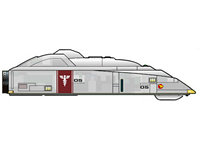
Along with the prototype testing of the first two models, Starfleet's imagined usage of their new multi-use shuttle grew with the development of the Medical version - basically an even longer version of the CNC shuttle, with a new upper deck. The MSU (Medical Staff Unit) contained seats for a doctor and 2 nurses as well as the bio-pharmaceutical, patient monitoring and first aid/surgical equipment. The lower main deck, behind the flight deck, contained 8 fold-down triage beds/seats. The initial trials were successful, though it was remarked by Admiral Thomas Chambers of Starfleet Medical Command to be slightly cramped and that a more powerful drive system was needed during heavy load missions. He went so far as to suggest an even larger variant should be built. Based on his recommendations, Starfleet Command agreed to continue the design and upgrade process at a later date after real-world test were completed. Starfleet's intention was to re-equip all medical starships large enough to house the shuttle with two units for use during tactical operations.
Production of the first Medical Shuttle began on August 14, 2289.
Transport Shuttle (TTS)
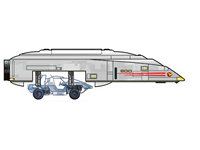
With the Starfleet Marines now interested in the multi-use shuttle system, a key concern for them was vehicle and resupply capability. SFRE ordered a pre-production Medical shuttle frame and asked their designers to re-enforce the frame and deck units with the addition of a 4-part grappling unit for both supplies and connecting via vehicle support units built-in to the wheeled or tracked vehicle frame. A test shuttle was made available on July 22, 2289 with test pilot Lt. Commander Paul Roberts at the helm, with Commander Hiram R. Jefferson as the co-pilot and test coordinator. During the first week of testing, Roberts encountered stability issues while performing a high speed, low-level vehicle release which resulted in fatal crash, killing both pilots. An inquiry by SFRE confirmed that the forward two arms of the vehicle grappling unit failed, causing the test vehicle to nose into the ground. The resulting impact while still connected forced the transporter to strike the ground and tumble several times before it exploded.
As a result of the loss, the transport version was shelved and the 3 pre-production test vehicles were grounded. On August 15, 2289, one of the pre-production vehicles began a ground test program to determine how the instability at high speeds and low level could be resolved. Several options, including having a detachable storage pod were brought forward, however, the additional weight factors would have required more powerful engines (which also added to the overall weight) and a 1/4 scale test vehicle proved just as unstable during trials. Starfleet R&E decided on a stop gap solution in order to have pre-production testing restarted by eliminating the "fast drop" from the flight profiles and test environments.
On September 9, 2289, flight tests and service trials continued. Production models were delivered from January 15, 2290.
Fighter Shuttle (TFS)
After the initial batches of production vehicles were delivered and field studies began, recommendations concerning design and internal improvements were submitted to SFRE. Some of the findings stated that if the design were to be used for combat vehicles, armor and weapons would need to be added. Finding the balance between improved performance and weight restrictions would be the key to the continuation of the program.
Beginning in February, 2290, SFRE requested that developers and builders from the Utopia Shipyards be brought in to give their input. After an exhaustive 6 month effort, a design review report was delivered to SFRE. A new armor mix and new engines as well the addition of phaser cannons would bring the design into a better tactical system. Utopia Shipyards created the Tactical Shuttle division and took over production of multi-use shuttle system. Production of the first Tactical Fighter Shuttle (TFS) was begun on October 1, 2290.
The fighter version included all of the improvements suggested in the Utopia report including a redesign of the fuselage and more powerful engines. The new armor, though a lighter composite mix, was thinner than yet just as strong as the original ceramic/transparent aluminum compound. The weight reduction in armor delivered improved performance and allowed the two man crew less sharing of responsibilities of operating the shuttle and allowed dedicated pilot and weapons officer/engineer to better focus on the individual tasks at hand. Deliveries began to the 45th and 92nd Starfleet Fighter Squadron and the 169th Starfleet Marine Strike Group on January 1, 2291 with amazing success. The new fighter units agreed that performance was outstanding for it's size and began field modifications to the TFS which included mounting of missile racks beneath or along the flanks of the fuselage. It's one drawback was protection to the aft section where the engines and docking/egress collar were located, though this improvement would come later in the Attack variant.
Eventually, 10 fighter squadrons and 5 strike squadrons were to carry the TFS and they are all still in use as of January, 2293.
Attack Shuttle, Heavy (HAS)
As part of the TFS program, another test bed was created based on the field modifications done by the 169th Starfleet Marine Strike Squadron and the requests for rearward protection. The result was another complete variant designated the HAS for Attack Shuttle, Heavy. Armor protection was increased overall based on the strike unit's propensity to draw fire as well as the addition of another turret mounted to the rear aft station. The rear turret required the addition of two further crewmembers - a rear turret gunner and a full-time engineer/communications officer.
Prototype testing began on December 29, 2291. The initial trials began with similar results to the fighter version, however, performance was slightly less due to extra personnel, weapons and equipment. A small buffeting problem was encountered with the upper turret in atmosphere, so a new cowling for the upper fuselage was developed and the buffeting ceased.
Delivery began, as with the TFS with the 169th Starfleet Marine Strike Group for operational testing. 6 squadrons now use the HAS with both Marine and Starfleet units.
Theben Class
Design by Daniel Gerson, description by USS Paladin
Type: Science ship
Proposed: 2268, commissioned: 2271
Length: 140.2m
Height: 46.8m
Beam: 74.2m
Crew: 93
Speed: Warp 7.58 (max.), Warp 7.0 (max. cruise), Warp 6.2 (cruise)
Armament: 4x Type-VI phaser emitters (fore), 1x Type-V phaser emitter (aft)
Auxiliary craft: 2x Type-22 midrange shuttlecraft, 2x Mk. IV work bees
The Theben class, a close relative of the Huxley and offshoot of the Excellentia technology program of the late 2260s is one of the numerous but unremarkable companions to the Oberth-class. The ship is meant as a small, medium range science ship, swifter than the outdated Oberth and more modular. A small saucer is integrated into a wide-bodied engineering hull, easily recognizable by the circular deflector and long set of bridge windows. Two small EnduranceMaster III nacelles extend from the engineering hull alongside the dorsal launch bay doors. The end of the ship has the typical Starfleet cutout, along with a shuttlebay for the Type-22 midrange shuttlecraft and any other auxiliary craft, such as Work Bees.
Impulse power is provided by a pair of sturdy SPU-IID units, which provide reasonable performance and long life. They are mounted on the neck, just behind the probe bay doors. Armament is minimal, with only five sets of relatively weak phaser emitters providing defense. A satisfactory shielding system enables the Theben to chase off most minor pirates or last until help can arrive, though the ship would not last long against a more capable opponent like a Bird of Prey.
The ship provides ample scientific capability, though its modular nature prevents it from being as efficient and purpose-built as the Oberth. A large sensor dome sits on a tower section above the bridge and provides excellent coverage, allowing the Theben to perform excellent astrometric scans. Advanced thermal imaging arrays and subspace transceivers dot the top of the hull and take up much of the forward compartments. Large probes can be launched via dorsal bay doors, a unique feature. The doors on the "neck" by the Impulse engines are meant to launch small payloads and scientific packages, while two larger bay doors are mounted on the ship's spine. They are capable of launching large probes, satellites, or specialized equipment packages, simplify manual cargo transfer and refitting.
The ship is also useful as a small freighter. A good sized shuttlebay provides easy access to the interior, as does the two large launch bay doors, which may also be used to load cargo. A standard round airlock is fitted to either side of the hull, providing maximum versatility for encounters with unknown or odd ships/stations. Interior cargo room for specimens and special equipment is ample. The Theben provides an easy to produce, simple science ship capable of performing cargo duties. A total of 954 were produced. 414 remain in service, with many of them acting as support ships for small colonies and the rest working as low level science ships or small freighters.
Thoth Class
Design by James Donovan
In service: 2289-2320
Length: 320m
16 decks
No description
Vandenberg Class
Design by Daniel Gerson
Type: Heavy cruiser
Start of development: 31.6.2288
First flight: 7.9.2290
Time in service: 2290-2360
Length: 285m
Beam: 150m
Height: 70m
Decks: 12
Speed: Warp 6 (cruise), Warp 8.5 (max.)
Crew: 70 officers, 244 enlisted
Weapons: 8 x Type VIII phaser banks, total output 12,500 terawatts, 4 x 2nd class photon torpedo tubes + 140 torpedoes
No description
Vanguard Class (1)
Design by John Bullerwell
Type: Scout
First commissioned: 2298
Length: 145m
Width: 106m
Height: 53m
Decks: 9
Complement: 10 officers + 164 crew, evacuation limit: 810
Speed: Warp 7 (cruise), Warp 8 (max.), Warp 9.1 (max. emergency)
Sublight speed: 0.66c (max.)
Armament: one torpedo launcher; four standard phaser emitters
Defense: Standard deflector shields
Embarked craft: none
A short-range scout-class ship. Small and efficient, the Vanguard class was designed primarily to supplement stationary outposts such as planetary starbases and colonies, as well as orbital complexes such as stations and drydocks. Based in part on the Excelsior class, its smaller warp engines still provide impressive cruising and emergency warp velocities. Its impulse engines were a testbed of sorts, providing new advances in subspace deceleration that would later be employed in every subsequent Starfleet class. They provide impressive surpluses of energy that lessen the energy requirements of secondary ship systems that would normally have been placed on the vessel's warp core. Initial designs of the class included a small, single vehicle shuttlebay located in the lower pylon, but this feature was eliminated because of its small profile and intricate position. (It was planed to be located on the fore side, directly above the redesigned navigational deflector.) The class design has a potential life expectancy of eight decades, though as always, this will be subject to current technologies and future technological breakthroughs.

